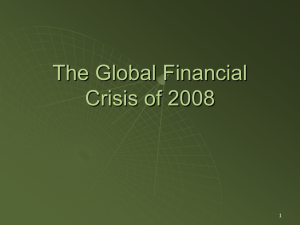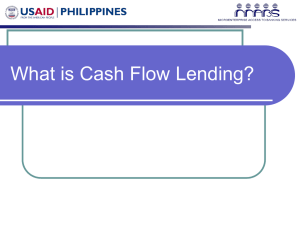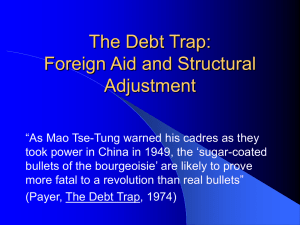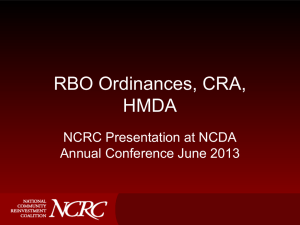Chapter 12
advertisement
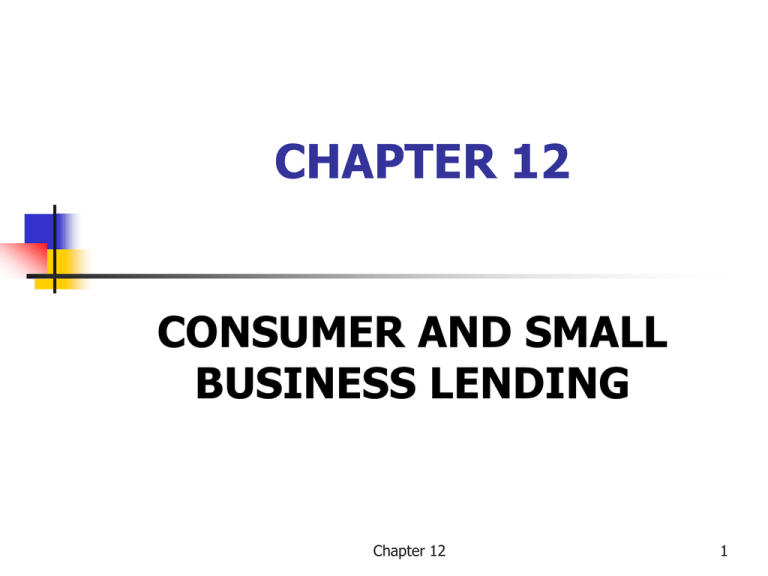
CHAPTER 12 CONSUMER AND SMALL BUSINESS LENDING Chapter 12 1 LEARNING OBJECTIVES TO UNDERSTAND… The markets for and importance of small-business lending, consumer installment lending, residential mortgages, and home-equity lines of credit The credit analysis, pricing, and risks of smallbusiness, consumer, and residential-mortgage lending Credit scoring for consumers and small businesses and how it can be misused The importance and growth of subprime lending and the outcry about “predatory practices” and attempts to regulate them The future of consumer and small-business lending Chapter 12 2 Overview of Consumer Lending At year-end 1985, commercial banks held total consumer loans of $284b, at the beginning of 2000, the figure was $558b (compound annual growth of 5%). Credit-card loans grew from $68b year-end 1985 to $212b at the beginning of 2000 (compound annual growth of 8.5%). Since year-end 1988, home-equity loans held by all commercial banks have grown from $35b to $98b at the beginning of 2000 (compound annual growth of 9.8%). Chapter 12 3 The Role of TRICK Transparency/disclosure/predatory practices have become major issues in subprime lending Risk exposure of subprime lending has got the attention of the market and regulators Information technology (credit scoring) plays a major in retail lending Chapter 12 4 The Role of TRICK (continued) Competition for customers has intensified especially for consumers and small businesses Capital adequacy always is an issue in banking and has surfaced with respect to subprime lending Chapter 12 5 Securitization Started with government-sponsored enterprises (GSEs such as Ginnie Mae, Fannie Mae, and Freddie Mac) and the residential-mortgage market Trickled down to credit cards and auto loans Chapter 12 6 The Characteristics of Small Businesses 500 employees of less => “small”, however, two-thirds of small businesses have fewer than five employees Location: 80% in urban areas SIC description Retail trade Business services Professional services Construction/mining All others Chapter 12 Percent 21.7 21.2 16.6 14.2 26.3 7 Financial Services Used by Small Businesses Three broad categories of services Liquid-asset accounts Checking and savings Credit lines, loans, and capital leases Financial-management services Cash management, brokerage, trust, pension Chapter 12 8 The Suppliers Depository institutions Nondepository institutions Table 12-3 (p. 397) shows that commercial banks dominate as suppliers of financial services to small businesses Finance company, brokerage, leasing Nonfinancial Family, individual, other businesses, government (SBA) Chapter 12 9 Credit Analysis and Credit Scoring Evolution from the 5Cs to credit scoring for consumers Small businesses stand on the far left-hand side of the borrower-information continuum (Ch. 10) – scare information that is costly to obtain Fewer than five employees => 5Cs approach might be best, especially character Chapter 12 10 Credit Scoring: Understanding FICO (Box 12-1, p. 400) Fair, Isaac & Co. is a risk-management company that have developed a creditscoring system referred to as FICO. A FICO score is based on information found within your credit report. The 5 basic categories of importance: 1. 2. 3. 4. 5. Payment History Outstanding Debt Credit History Pursuit of New Credit Types of Credit in Use Chapter 12 11 Credit Scoring and DecisionMaking Figure 12-1 (p. 401) illustrates the trade-off at origination between credit score and the loan-to-value (LTV) ratio Don’t short change the importance of human judgment Chapter 12 12 Consumer Lending Loan category 2000 (growth)* Residential mortgages $ 839B (12.2%) Installment loans $ 346B ( 3.0%) Credit-card loans $ 212B (10.2%) Home-equity loans $ 98B (13.4%) Total $1,495B ( 9.8%) *Amount at the beginning of 2000 and growth rates since 1985 (1988 for home equity) Chapter 12 13 Consumer Installment Credit: Market Share and Types of Loans Types: Revolving (credit cards) and nonrevolving Holders/Suppliers Commercial banks Finance companies Credit unions Savings institutions Nonfinancial business (GE, GMAC) Pools of securitized assets Chapter 12 14 The Cost of Making Consumer Loans (functional cost analysis) Cost categories Office space Supplies Services Labor Tables 12-9, 12-10, 12-11 (pp. 408410) present FCA data Chapter 12 15 Credit Analysis For Consumer Lending Five stages in the analysis of new customers: 1. Initial contact or introduction, 2. Credit application, 3. Review of the application, 4. Credit analysis or evaluation, and 5. Monitoring and control Chapter 12 16 CAMPARI An alternative to the five Cs of credit analysis is CAMPARI. In contrast to the five Cs, the CAMPARI framework is more specific with respect to the purpose and terms: Character – the first of the five Cs Ability – in managing financial affairs Margin – interest rate, commission, and fees Purpose – of the loan Amount – of the loan Repayment – probability of Insurance – the collateral component of the five Cs Chapter 12 17 A System Approach Versus Individual Appraisal Credit-scoring systems have been in use for years Examples of variables Years on job Home phone Years at address Major credit card Credit bureau information Chapter 12 18 Predicting Personal Bankruptcy Research frameworks similar to those used in predicting corporate bankruptcy (classification models, Ch. 11) Three national credit bureaus predict personal bankruptcies Equifax Trans Union TRW Chapter 12 19 Residential Real-Estate Lending: Mortgages and Home-Equity Lines of Credit One of the biggest changes in bank consumer lending has resulted from the restructuring of the savings-and-loan industry. At the end of 1985, all commercial banks held $188b in loans backed by one-to-four family residential property. In 1999, it was $767b or annual growth of 10.6%. Chapter 12 20 Growth Residential mtgs Bank size Growth* Small 4.9% Medium 11.5% Large 14.4% Top ten 12.9% All banks 10.4% *1985-1999 Chapter 12 Home-equity loans Bank size Growth* Small -1.5% Medium -4.3% Large 6.8% Top ten 17.5% All banks 5.4% *1994-1999 21 The Restructuring of Residential Lending Fragmentation of the mortgage-lending process (securitization steps) Origination Funding/underwriting Selling Servicing Investor Chapter 12 22 Subprime Lending Subprime portfolios are those made up of loans to borrowers with higher-risk characteristics defined to include: A FICO score of 660 or lower Two or more 30-day delinquencies in the past year Bankruptcy in the last five years A debt-to-income ratio of 50% or higher A foreclosure, repossession, or charge-off in the preceding 24 months Chapter 12 23 Myths About Subprime Lending Myth #1: Subprime lending has been responsible for record homeownership rates among minorities and lower-income groups Myth #2: By and large, subprime lending is priced efficiently Myth #3: Proposed legislation is counterproductive Chapter 12 24 The Future of Consumer and Small-Business Lending Forces shaping the future Regulation (Table 12-17, p. 423) Interest-rate controls cause distortions (Figure 12-3, p. 422) New sources of fee and choice Automation and securitization Chapter 12 25 Consumer Banking Innovations Credit and debit cards ATMs that permit cash advances (loans) Systems approaches to lending Home-equity loans On-line banking Chapter 12 26 CHAPTER SUMMARY Consumer and small-business lending Installment loans (credit cards) Residential mortgages Home-equity lines of credit Loans and financial services for small businesses Credit scoring and securitization Subprime lending Chapter 12 27
